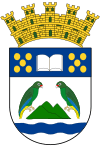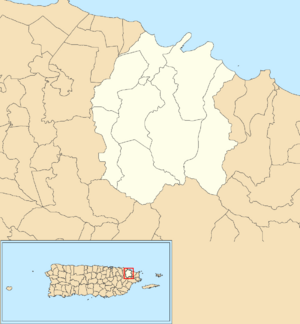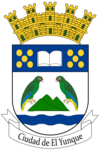Río Grande, Puerto Rico facts for kids
Quick facts for kids
Río Grande
Municipio de Río Grande
|
|||
|---|---|---|---|
|
City and municipality
|
|||
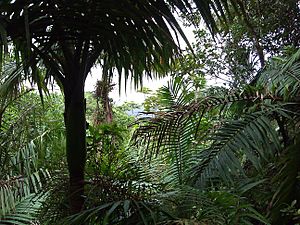
Trees in Mameyes II, Río Grande
|
|||
|
|||
| Nickname(s):
"La Ciudad de El Yunque"
|
|||
| Anthem: "Entre las ondas que juguetean" | |||

Map of Puerto Rico highlighting Río Grande Municipality
|
|||
| Sovereign state | |||
| Commonwealth | |||
| Settled | 1820 | ||
| Founded | July 16, 1840 | ||
| Founded by | Don Desiderio Escobar | ||
| Barrios |
9 barrios
Ciénaga Alta
Ciénaga Baja Guzmán Abajo Guzmán Arriba Herreras Jiménez Mameyes II Río Grande barrio-pueblo Zarzal |
||
| Area | |||
| • Total | 89.6 sq mi (232.11 km2) | ||
| • Land | 60.7 sq mi (157.28 km2) | ||
| • Water | 28.9 sq mi (74.83 km2) | ||
| Elevation | 23 ft (7 m) | ||
| Population
(2020)
|
|||
| • Total | 47,538 | ||
| • Rank | 16th in Puerto Rico | ||
| • Density | 530.56/sq mi (204.808/km2) | ||
| Demonym(s) | Riograndeños | ||
| Time zone | UTC−4 (AST) | ||
| ZIP Codes |
00721, 00745
|
||
| Area code(s) | 787/939 | ||
| Major routes | |||
Río Grande is a town and municipality in Puerto Rico. It is located on the eastern coast of the island. The town is known for being home to a large part of the El Yunque National Forest.
Río Grande is surrounded by other towns. To its north is the Northern Coastal Valley. To the east are Luquillo, and to the west are Loíza and Canóvanas. South of Río Grande are Las Piedras, Naguabo, and Ceiba.
Contents
History of Río Grande
Río Grande was officially founded on July 16, 1840. It was started by Desiderio and Quilimaco Escobar. The name "Río Grande" comes from the Río Grande river. This river joins with the Río Espíritu Santo river in the area.
In 1894, the area had many farms. There were two large sugar cane farms and 256 smaller farms. These smaller farms grew fruits and other crops.
Hurricane Maria's Impact
On September 20, 2017, Hurricane Maria hit Río Grande. The heavy rain caused many landslides. Buildings were damaged, and trees were pulled from the ground. Rivers overflowed, causing damage to about 5,000 homes. Luckily, 230 Puerto Rican amazon parrots that were in captivity survived the storm.
Geography and Nature
Río Grande is located on the northeastern coast of Puerto Rico. It sits north of the Sierra de Luquillo mountains. A big part of the El Yunque National Forest is within Río Grande.
Mountains and Peaks
Some of the highest points in the Sierra de Luquillo mountains are in Río Grande. These include El Yunque and El Toro. El Toro is the tallest peak in eastern Puerto Rico, standing at 3,474 feet (1,070 meters) high.
Barrios: Neighborhoods of Río Grande
Like all towns in Puerto Rico, Río Grande is divided into smaller areas called barrios. These are like neighborhoods or boroughs. The main town area, with the government buildings and a large church, is called Río Grande Pueblo.
Here are the nine barrios of Río Grande:
- Ciénaga Alta
- Ciénaga Baja
- Guzmán Abajo
- Guzmán Arriba
- Herreras
- Jiménez
- Mameyes II
- Río Grande barrio-pueblo
- Zarzal
Sectors: Smaller Areas
Barrios are further divided into even smaller areas called sectores. These sectors can have different names. For example, some are called urbanización (urbanization) or residencial (residential area).
Special Communities
Some communities in Puerto Rico are called Comunidades Especiales. These are areas where people might face challenges. In Río Grande, some of these special communities include:
- Sector Montebello and Sector El Hoyo in Malpica
- Las Dolores
- La Ponderosa
- Villa Realidad
- Estancias del Sol
- Hong Kong
Population and People
In 1894, when Puerto Rico was a Spanish colony, Río Grande had 6,237 people. After the Spanish–American War in 1898, Puerto Rico became a territory of the United States. In 1899, the population of Río Grande had grown to 12,365 people.
The population has continued to grow over the years. In 2020, the population of Río Grande was 47,060 people.
Tourism and Fun Activities
Río Grande is a popular place for tourists. It has many beautiful beaches and resorts.
Beaches and Resorts
One of the largest private beach areas on the island is Coco Beach. Major hotels in Río Grande include:
- The Wyndham Grand Rio Mar Beach Resort and Spa
- Hyatt Regency Grand Reserve
- St. Regis Bahía Beach Resort & Golf Club
The Hyatt Regency Grand Reserve hosts the PGA Tour's Puerto Rico Open golf tournament every March.
El Yunque National Forest
Just a short drive away is El Yunque National Forest. This is the only tropical rainforest in the United States National Forest System. It's a great place to explore nature and see waterfalls.
Other Places to Visit
Río Grande has 27 beaches in total. Other interesting places to visit include:
Economy and Business
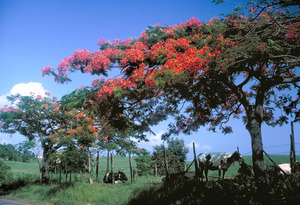
Río Grande has a mix of agriculture and business.
Farming and Crops
Farmers in Río Grande grow many different things. They produce fruits, vegetables, and ornamental plants. They also grow tobacco and raise cattle.
Local Businesses
You can find many local shops along PR-3. There is also a large shopping mall. The area has attracted many hotels and sports venues. In 2012, Puerto Rico Highway 66 opened. This highway makes it easier to travel to San Juan.
A group called the Consejo Comunitario de Seguridad de Río Piedras helps local businesses with safety. They work to make sure that shoppers feel safe in the downtown area.
Culture and Events
Río Grande has many fun festivals and events throughout the year.
Festivals and Celebrations
The town celebrates its patron saint festival in July. This event is called the Fiestas Patronales de Nuestra Señora del Carmen. It's a religious and cultural celebration with:
- Parades
- Games
- Local artists selling crafts
- Amusement rides
- Traditional food
- Live music and shows
Other festivals in Río Grande include:
- Río Grande Carnival – Held in July
- Stuffed Potato Festival – Held in April
- Las Picúas Festival – Held in September
Sports in Río Grande
Popular sports in Río Grande include baseball, basketball, and handball.
Famous People from Río Grande
Many notable people have come from Río Grande, including:
- Antonio Bachour – A famous pastry chef.
- Raymond Burgos – A Major League Baseball pitcher.
- Ovidio de Jesús – A sprinter who competed in international events.
- Luis Pizarro – A boxer who competed in the 1980 Summer Olympics.
- Rafael Quintero – A diver who competed in the 2016 Summer Olympics.
Symbols of Río Grande
The municipality of Río Grande has its own official flag and coat of arms.
The Flag
The flag of Río Grande has two equal horizontal stripes. The top stripe is green, and the bottom stripe is blue. A white triangle is placed on the side closest to the flagpole. On this white triangle, you can see a Puerto Rican parrot.
The Coat of Arms
The coat of arms has a silver background. It shows two Puerto Rican parrots. There is also a wavy blue stripe and a green mountain with three peaks. The top part of the shield is blue and has an open silver book. On each side of the book are five gold coins. On top of the shield is a gold crown with three towers.
Images for kids
See also
 In Spanish: Río Grande (Puerto Rico) para niños
In Spanish: Río Grande (Puerto Rico) para niños



